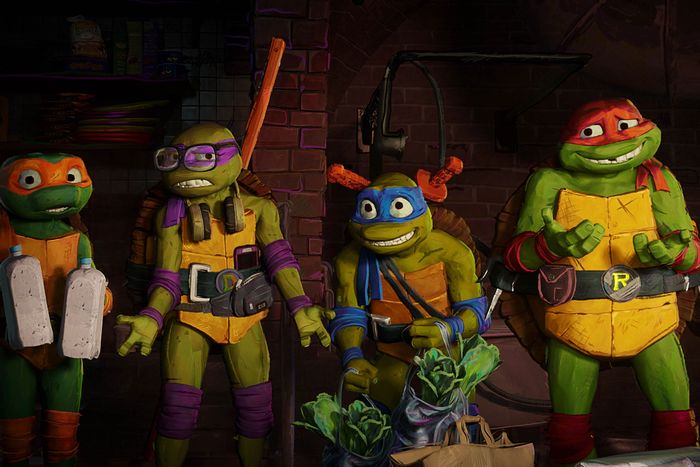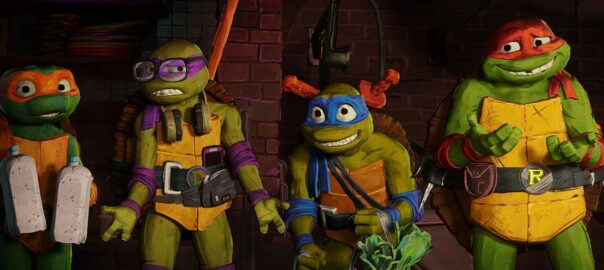[ad_1]

Photo: Courtesy of Paramount Pictures./B)2023 Paramount Pictures.TEENAGE MUTANT NINJA TURTLES is a trademark of Viacom International Inc.
Leonardo (the leader), Donatello (the tech wiz), Raphael (the brawn), and Michelangelo (party dude) have been played by guys in foam latex costumes designed by Jim Henson’s Creature Shop. They’re been CGI creations with the smooth, plastic look of an earlier era of digital animation, and, more recently, they’ve been disconcertingly brawny, with prominent nostrils and an overtly scaly texture. In Teenage Mutant Ninja Turtles: Mutant Mayhem, the characters’ seventh big-screen outing, they look different yet again — this time as though someone colored them in with markers and then added details with a ballpoint pen. After a three-decade journey toward something approaching realism, the turtles are no longer trying to resemble actual terrapins who’ve mutated into human-size bipedal beings, maybe because that prospect is actually terrifying. Now they bring to mind a heightened version of something a kid might doodle on the inside of a binder during class, the perfect take on characters who began life as a parody of superhero comics. They’ve never looked better.
They’ve also never looked younger, apart from flashbacks of them as babies. Mutant Mayhem, which comes from The Mitchells vs. the Machines co-director Jeff Rowe, leans hard into the “teenage” aspect of the foursome, with a young cast (Nicolas Cantu, Micah Abbey, Brady Noon, and Shamon Brown Jr.) voicing characters whose deepest desire is to emerge from the sewers and enroll in high school. TV reporter April O’Neil (Ayo Edebiri) has also been reimagined as a kid, turned into a scooter-riding aspiring journalist whose interest in investigating New York’s recent crime wave is guided by her desire to reinstate her canceled prom and thereby fix her outcast status. These choices give the movie an easygoing sweetness, turning it into a coming-of-age story as much as it is one about saving the world. It eventually gets to that too, of course, but not in a hurry. The movie is much more interested in hanging out with these characters as they do things like film themselves doing IRL Fruit Ninja stunts.
In this iteration, the turtles’ mutant-rat mentor Splinter (Jackie Chan) is more like an overprotective parent scarred from rough encounters with humanity, and despite having trained with him, the boys haven’t ever been in a real fight before the film begins. They begin looking for the culprit behind some recent robberies, the mysterious Superfly (Ice Cube), only because they have ulterior motives. The plan is for April, who becomes their first human friend after an unfortunate throwing-star incident, to document the turtles catching the baddie, winning them acceptance from a city otherwise inclined to treat them like monsters. Instead, they discover that Superfly is an actual fly as well as the head of a band of fellow mutants, among them warthog Bepop (Seth Rogen), rhino Rocksteady (John Cena), alligator Leatherhead (Rose Byrne), bat Wingnut (Natasia Demetriou), the self-explanatory Mondo Gecko (Paul Rudd), and manta ray Ray Fillet (yes, Post Malone). These mutants also crave acceptance from the rest of the world, though they’re going about it the blunt-force way, by aiming to turn all the other creatures out there into mutants in order to become the majority.
Mutant Mayhem, which Rowe wrote with producers Rogen and Evan Goldberg as well as Dan Hernandez and Benji Samit, sometimes comes off as a little too slack, with its teen-dirtbag ’90s hip-hop vibe leaning toward oddly languid for a movie that’s for kids as much as it is about them (in turtle form). But it’s just so charming anyway. The turtles’ unceasing, rapid-fire banter is all affectionate dunks on one another and pop-culture quips, and the look of the film is never less than entrancing, with computer animation that creates the feel of something handmade. Like the Spider-Verse movies, Mutant Mayhem thrums with all the possibilities of its medium, an ebullience that escalates as it approaches a chaotic finale that evokes the kaiju genre as much as it does Ghostbusters-era comedies about New York grubbiness. It’s a final act that could only work in animation and is downright joyous to behold because of it. This medium, for all of its recent and illuminating labor issues, remains the painstaking work of talented artists, and there’s something lovely about the way Spider-Verse, with its Ben Day dots, and Mutant Mayhem, with its scribbles of pen line shading, evoke the analog past despite being made using the latest advancements in technology. Those touches give these films a sense of life and warmth that can’t be ignored.
See All
[ad_2]
Source link
